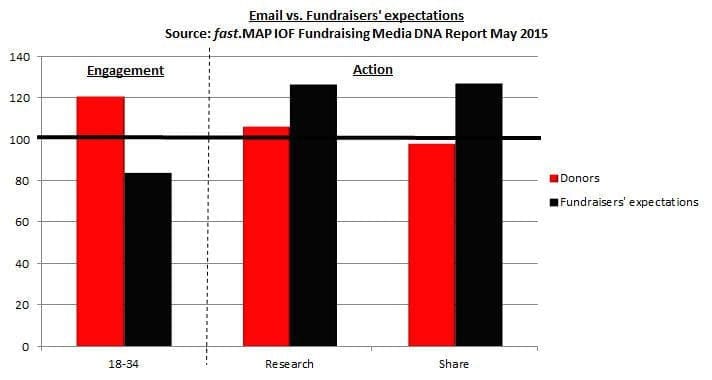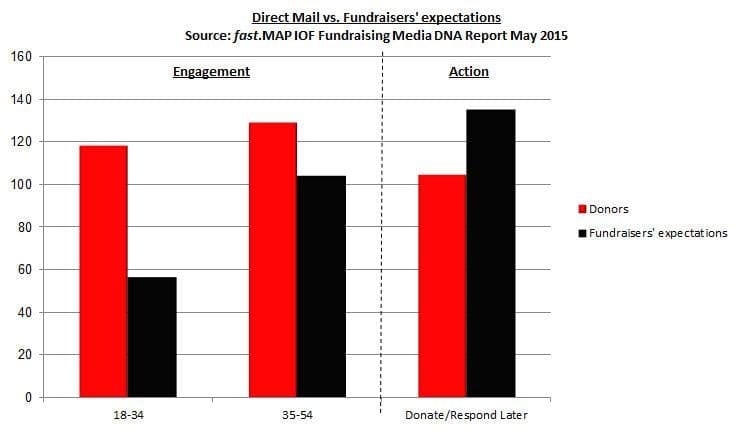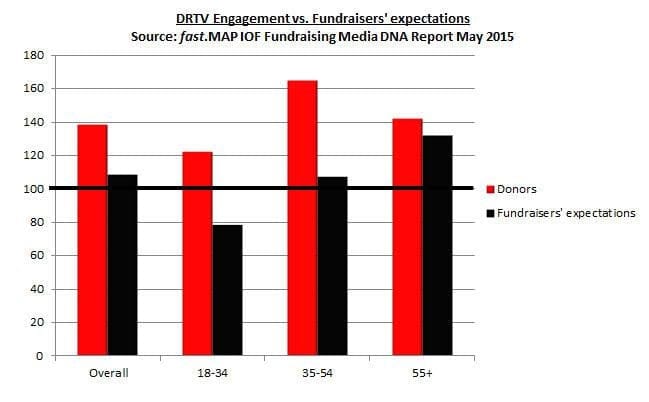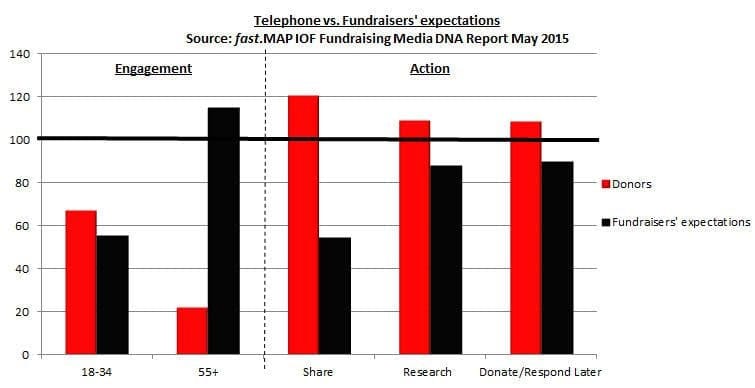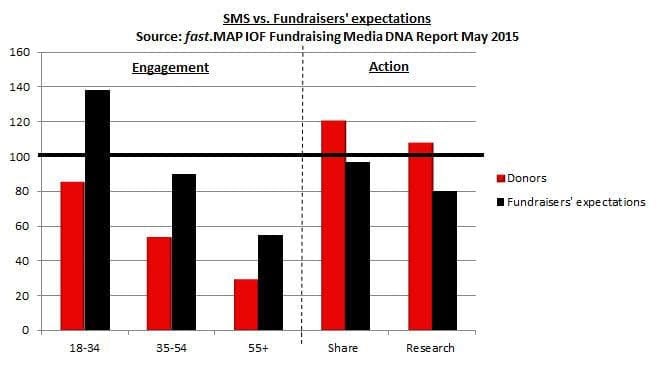Fundraising Media DNA: the most common misconceptions by fundraisers
There is no doubt that expertise and experience are invaluable fundraising talents, but there are some areas where gut instinct is unreliable.
In the fifth analysis of the Fundraising Media DNA Report by fast.MAP and the Institute of Fundraising, we look at how fundraisers’ assumptions and expectations do not always match the data.
Sweeping assumptions about the popularity of various charity media can, of course, lead to missed opportunities. The fact that DRTV is more likely to appeal to 35-54’s than to over 55’s seems counter-intuitive, but it’s a fact which could be utilised when the younger group is being targeted.
Fundraisers also underestimate 18-34s’ level of engagement with telephone, email and direct mail; and misjudge donors’ overall willingness to share SMS with others
Conversely, they overestimate donors’ level of engagement with social media and DRTV as well as the over 55s’ enthusiasm for telephone contact. Some other misconceptions included the number of times emails are shared and people’s likelihood to donate or respond later to direct mail.
Below are the channels fundraisers misjudge most frequently and why.
Email is known to be popular among younger age groups, but fundraisers underestimate 18-34s’ engagement with it. They failed to anticipate the high email index score for this group (Engagement Index, 18-34; Estimate 84 vs. Actual 121, where 100 is average).
Another misconception is the number of times recipients share emails (Share Index; Overall, Estimate 127 vs. Actual 98) and research further (Research Index; Overall, Estimate 127 vs. Actual 106). Donors are more likely to research further as a result of receiving an email than they are to donate later (Donate/Respond Later Index; Overall 104). This suggests fundraisers should include strong calls-to-action within emails and on the web pages donors may use for research.
Direct mail
Charities correctly identify that direct mail is popular. But they over-estimate its overall popularity (Engagement Index; Overall, Estimate 139 vs. Actual 131) while massively underestimating its appeal to 18-34s (Engagement Index; 18-34, Estimate 57 vs. Actual 118) and 35-54s (Engagement Index; 35-54, Estimate 104 vs. Actual 129). This emphasises the importance of not making assumptions about certain age bands’ preferences.
What’s more, fundraisers – while identifying people’s most likely response to direct mail is to donate/respond later – expect far more people to do so than is the case (Donate/Respond Later Index; Estimate 135 vs. Actual 105). Recipients are also fairly likely to research further (Research Index; Overall, 100), so it is worth including links to research material to keep them engaged and motivated to donate.
Advertisement
DRTV
Charities not only underestimate the overall appeal of DRTV, they also misjudge its level of popularity among different age groups. They believe it is of more interest to the over 55s (Engagement Index; 55+, Estimate 131 vs. Actual 141) than the 35-54s (Engagement Index; 35-54, Estimate 107 vs. Actual 164). In fact, the younger group’s engagement score is much higher.
Generally, fundraisers underestimate the mass appeal of DRTV which makes it a suitable starting point for many acquisition campaigns.
Telephone
Although the 18-34s’ score for telephone engagement is low (Engagement Index; 18-34, Estimate 55 vs. Actual 67) it is still significantly higher than those of the older age groups. But fundraisers fail to anticipate this and presume it to be least popular among the youngest group – an indication of how mistaken they can be.
Telephone over-indexes for some attributes (Share Index; Overall, 120) (Research Index; Overall, 109) (Donate/Respond Later Index; Overall, 108) and is a strong conversion vehicle, but it needs to be used to contact those who engage with it. Preconceived ideas about which groups these are will potentially waste both budget and opportunities.
SMS
Fundraisers massively overestimate all age groups’ engagement with SMS, particularly that of the 18-34s. Although mobiles are most popular among the younger group, they do not favour SMS for all communication. Fundraisers believe SMS is a preferred donor channel; in fact it significantly under-indexes (My preferred way to hear from a charity Index; Overall, 66)
Fundraisers underestimated donors’ willingness to share SMS charity messages (Share Index; Overall, Estimate 97 vs. Actual 121) and fail to recognise its power to motivate research (Research Index; Overall, Estimate 80 vs. Actual 108). This indicates it could be beneficial for charities running SMS campaigns to encourage recipients to share the message via other channels such as social media.
What people say about fundraisers’ misconceptions
“As a channel, the telephone has come under much scrutiny recently and this research highlights both the challenges it faces and the benefits it delivers. On the positive side, the telephone scores most highly on ‘response’, with every response attribute indexing above the average fundraising channel, clearly demonstrating its ongoing value to charities and their beneficiaries in terms of generating income.
“There is, however, a need to look beyond response metrics when measuring the success of any campaign. It was disappointing to see ‘engagement’ index below average in a channel which enables charities to have direct conversations with the public.
“The research shows there is important work to be done to improve supporter engagement in these conversations. There remains a challenge between balancing sticking rigidly to pre-agreed scripts to ensure compliance, whilst enabling supporters and fundraisers to have more natural and engaging conversations.”
Tony Charalambides, Managing Director, Listen
“The dilemma when it comes to fundraising or raising a charity’s awareness is that, while we are unique individuals, to some extent we need to generalise when it comes to broader communications. However, as these results show, it can be all too easy to over-generalise or stereotype, based on what we have done before and believe is the best outcome of previous campaigns. To a certain extent, the narrowing of focus to high responding groups is responsible for much of the bad press the sector has experienced recently.
“One of the advantages of this research is to make us stop and think. For example, we can see that direct mail engages 18-34s and 35-54s far more than we realise (Engagement Index; 18-34, Estimate 57 vs. Actual 118) (Engagement Index; 35-54, Estimate 104 vs. Actual 129).
“Overall though, it is vital to tailor the message to the audience, or even the individual. What’s going to motivate a new parent to donate will be different to someone who has seen their son or daughter graduate university and enter the world of work.”
Scott Logie, MD, REaD Group Insight
“These results should help fundraisers to think about how they are engaging with supporters and whether there are opportunities they could be taking advantage of. The findings from different age groups and demographics should provide some food for thought so fundraisers can tailor current and future communications appropriately.
“It is also interesting to see that on some channels there may be a ‘disconnect’ between the action donors take and what fundraisers anticipate they’ll do. For example, it seems that sending an SMS is more likely to prompt ‘further research’ from donors than fundraisers thought, while sending a piece of direct mail perhaps is less likely to result in an immediate donation than fundraisers had predicted. The important thing is for fundraisers to always be proactive in thinking about their messages and the channels they use, to make sure their communications are relevant to their audience”.
Daniel Fluskey, Head of Policy and Research, Institute of Fundraising
“Hopefully, this research will provide fundraisers with valuable insights for planning their campaigns. They cannot assume that because a medium has inherent qualities (for example, email is easy to share and tends to motivate further research) that donors will take these actions without being prompted or given a good reason – such as a compelling story or clear suggestions about ways they can help. (Share Index; Overall, Estimate 127 vs. Actual 98) (Research Index; Overall, Estimate 127 vs. Actual 106).
“The extent to which fundraisers underestimate the popularity of DRTV campaigns – particularly strong among 35-54s (Engagement Index: 35-54, Estimate 107 vs. Actual 164) – is surprising. Charities would do well to further explore this group’s motivations and the triggers which could move them to engage and donate. This can be achieved by pre-testing a concept or idea before going into full production, giving the campaign the best possible chance of generating funds.”
David Cole, Managing Director, fast.MAP



